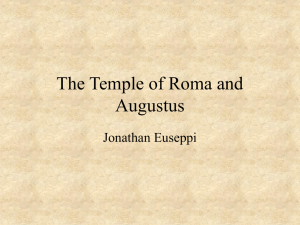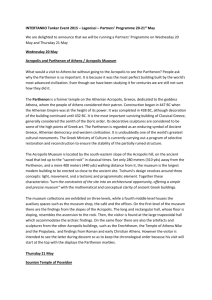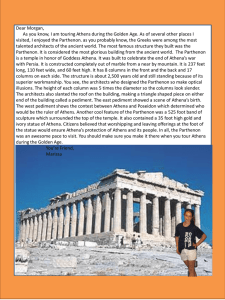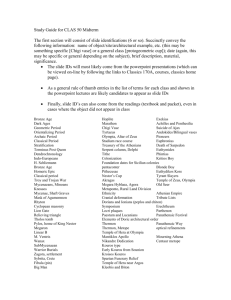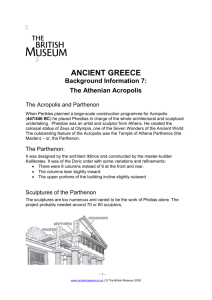the doric essence
advertisement
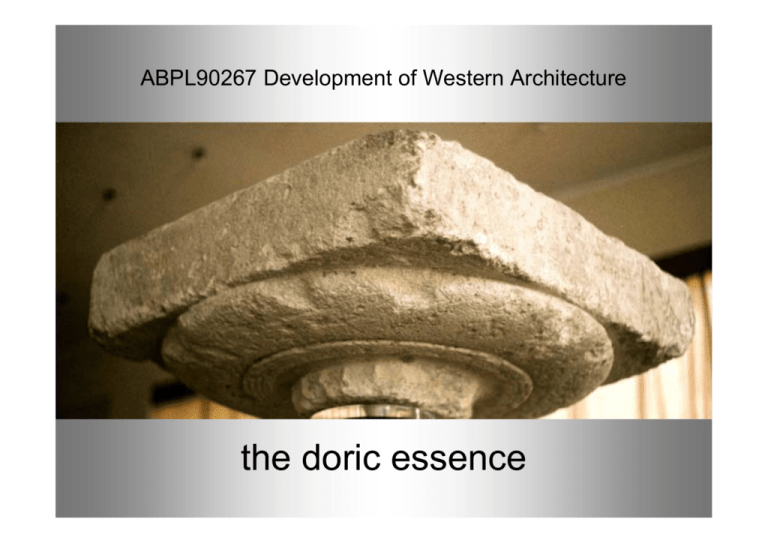
ABPL90267 Development of Western Architecture the doric essence COMMONWEALTH OF AUSTRALIA Copyright Regulations 1969 Warning This material has been reproduced and communicated to you by or on behalf of the University of Melbourne pursuant to Part VB of the Copyright Act 1968 (the Act). The material in this communication may be subject to copyright under the Act. Any further copying or communication of this material by you may be the subject of copyright protection under the Act. do not remove this notice from masonry to timber to masonry proto-doric column chamfering & fluting the echinus and abacus capital synthesis of the echinus and the fluted shaft from rubble to ashlar (dressed stone) at Samos from wooden to stone columns at Olympia proto-doric chamfering and fluting tomb chapel of Amenemhat, Beni Hasan, c 2000 BC ; Portico of Anubis Deir-el-Bahari, Egypt, c 1490 BC ; column from Assur, c 1050 BC Lewis, Architectura, p 176; Miles Lewis the echinus and abacus capital Palace of Knossos, c 1600-1400 BC; Treasury of Atreus, Mycenae, c 1325 Knossos slide set, no 1; Miles Lewis the synthesis of the echinus capital and the fluted shaft model column fragments: fluted column; chamfered half column: National Museum, Athens, no s 7529,7591; Minoan column from Gortyn, C13th BC, Herakleion Museum Miles Lewis the first Heraeum, Samos, mid C8th: plan the 2nd Heraeum, Samos, mid C7th: plan and reconstructed section Scranton, Greek Architecture, pl 23 J J Coulton, Greek Architects at Work (London 1977), p 33 Heraeum, Samos visible masonry of the second temple, C7th BC with excavated masonry of the first temple, C8th BC Miles Lewis Coulton, Greek Architects at Work, pl 3 Temple of Hera, Olympia, as rebuilt late C7th inset: the opposite end, showing the opisthodomos, including a stone base for a wooden column Jeff Turnbull the archaic Doric early Doric capitals early C6th BC, Temple of Artemis, Corfu c 580 old tholos, Delphi c 570 BC, older Temple of Aphaia, Aegina c 565 'Basilica' Paestum, Italy c 530 Temple of Athena or Ceres, Paestum c 510 Temple of Hercules, Agrigento (Sicily) archaic doric capitals old tholos, Delphi, c 580 older Temple of Aphaia, Aegina, c 570 BC Temple of Artemis, Corfu, early C6th BC ?Temple of Hercules, Agrigento, c 510 Scranton, Greek Architecture, pl 29 Miles Lewis Paestum, Italy: aerial view of the Temple of Neptune or Poseidon, c 450 (top), and the 'Basilica', c 565 (bottom) MUAS 15,775 'Basilica', Paestum, c 565: east flank Miles Lewis 'Basilica', Paestum, c 565: detail of a capital Miles Lewis Temple of Athena or Ceres, Paestum, c 530 details of capitals view Miles Lewis Robertson, Greek and Roman Architecture, p 80 MUAS 3,451 Temple of Athena Pronaia at Delphi, c 570 BC Temple of Apollo at Syracuse, 570-560 BC first Temple of Aphaia at Aegina, 570 BC early Doric columns Alexander Tzonis & Phoebe Giannisi, Classical Greek Architecture: the Construction of the Modern (Flammarion, Paris 2004), p 83 the Doric order elements of the capital restoration of the order at the Temple of Zeus, Olympia, c 460 Miles Lewis Robertson, Greek and Roman Architecture, p 40 comparative Doric orders Miles Lewis Doric columns at Delphi, by Gruben Helmut Berve & Gottfried Gruben, Greek Temples Theatres and Shrines Harry N Abrams, New York, no date), p 331 Temple of Aphaia, Aegina, c 490 BC cutaway view by Mansell Second Temple of Hera (‘Poseidon’), Paestum, c 460 BC the Parthenon, Centennial Park, Nashville, Tennessee, 1897-1939 Monumentum, IX (1973), p 46 Hephæsteion, Athens, c 449-444 BC: view from south-west unspecified: 1979 HephæsteionAthens c 449-444 BC view & (new) plan Miles Lewis Scranton, Greek Architecture, fig 4 Hephæsteion, Athens c 449-444 BC plan Scranton, Greek Architecture, fig 4 the 2n + 1 rule for columns 2:5 distyle 4:9 tetrastyle 6:13 hexastyle 8:17 octastyle 10:21 decastyle 12:25 dodecastyle Temple of Hephæstos, Athens c 449-444 BC plan Scranton, Greek Architecture, fig 4 Temple of Poseidon, Cape Sounion, 444-440 BC axonometric restoration Trewin Copplestone [ed], World Architecture (London 1963), p 47, pl 109 the possible wooden origins of the Doric order by A von Gerkan, 1948-9, & anonymous T G Smith, Classical Architecture: Rule and Invention (Layton [Utah] 1988), p 15 Jim Harter [ed], Images of World Architecture (New York 1990), p 54 the Archaic hexastyle peripteral temple of Athena, Athens: reconstruction of the wooden origins of the Doric order Economakis, Acropolis Restoration, p 21 wood construction of the Doric order Cyclopedia of Architecture, Carpentry and Building (10 vols, American School of Correspondence, Chicago 1909), vol 8, p 54 Hephæsteion, Athens, c 449-444 BC detail of the entablature Miles Lewis Hephæsteion, Athens, c 449-444 BC underside of the roof Miles Lewis Hephaisteion, ceiling plan W B Dinsmoor, ‘The Roof of the Hephaisteion’, American Journal of Archaeology, 80(3) (1976), p 225 conjectural sections of the Parthenon, Athens Royal Institute of British Architects Journal, 25 February 1928, p 265 Parthenon, Athens, by Iktinos & Kallikrates, 447-432 BC view from the Propylaea Frank Sear the Parthenon: revised plan Richard Economakis [ed], Acropolis Restoration: the CCAM Intervention (Éditions, London 2007), p 45 Partheon, reconstruction view, British Museum Miles Lewis the Parthenon Lewis, Architectura, p 181 OPTICAL ADJUSTMENTS IRREGULARITIES OPTICAL REFINEMENTS OPTICAL CORRECTIONS optical adjustments 1 TAPER Parthenon: central intercolumniation of the west end unsourced the taper of columns as prescribed by the Roman architect Vitruvius, in his De Architectura These proportionate enlargements are made in the thickness of the columns on account of the greater heights to which the eye has to climb. For the eye is always in search of beauty, and if we do not gratify its desire for pleasure by a proportionate enlargement in these measures, and thus make compensation for ocular deception, a clumsy and awkward appearance will be presented to the beholder Marcus Vitruvius Pollio [Vitruvius] [translated M H Morgan], The Ten Books on Architecture (modern edition, New York 1960 [1914]), pp 84/86. Book I, ch III, 12 the columns of the Parthenon Richard Economakis [ed], Acropolis Restoration: the CCAM Intervention (Éditions, London 2007)), p 18 optical adjustments 2 ENTASIS it is a swelling outside the line of the taper, but inside the vertical it is (approximately) an arc of a circle no part of the column is wider than the base – it is not cigar-shaped Vignola’s rule for entasis (compared with the actual entasis of the temple of Mars Ultor in Rome) Marcus Vitruvius Pollio [translated M H Morgan], The Ten Books on Architecture (1916), p 87 a purported rationale for entasis to counteract the visual necking effect of a column when seen against the light E-E Viollet-le-Duc, Entretiens sur l'Architecture, I (Paris 1868), p 250 early examples of entasis are clearly perceptible ergo, it cannot be an optical correction the 'Basilica', Paestum, midC6th to early C5th: corner Miles Lewis optical adjustments 3 ADJUSTED SPACING ideal rules: • the columns are evenly spaced • the triglyphs are evenly spaced • every second triglyph is on the axis of a column Tholos, Delphi, c 400 view & detail of entablature & view. MUAS 14,007 the Parthenon, part-elevation Maria Casanaki & Fanny Mallouchou, The Acropolis of Athens: Conservation Restoration and Research 1975-1983 ([Athens] 1983), p 36 in a rectangular building you cannot satisfy the ideal rules, ie the columns are evenly spaced the triglyphs are evenly spaced every second triglyph is on the axis of a column unless you leave a spare piece of metope at the corner the problem of the angle triglyph: three approaches Miles Lewis Temple of Artemis, Garitsa, Corfu, c 600 BC, reconstructed end elevation. Robertson, Greek and Roman Architecture, p 107 small spacing (most apparent at abacus level) normal moving the corner column inwards Temple of Artemis, Garitsa, Corfu, c 600 BC, reconstructed end elevation. Robertson, Greek and Roman Architecture, p 107 diagram showing the angle contraction achieved by reducing the intercolumniation (ie moving the corner column inwards) Coulton, Greek Architects at Work, p 61 Temple of Athena (Ceres), Paestum, c 510 BC: reconstruction F Krauss, Die Tempel von Paestum (Gasamptpublikation, 1959 ff) big metope moving the corner triglyph outwards Temple of Athena (Ceres), Paestum, c 510 BC: reconstruction F Krauss, Die Tempel von Paestum (Gasamptpublikation, 1959 ff) Temple of Concord, Agrigento, c 450 BC: detail of the east end Miles Lewis the Parthenon, Athens detail of north-east corner of the entablature part elevation George Dontas, The Acropolis and its Museum (Athens 1987), p 56 Maria Casanaki & Fanny Mallouchou, The Acropolis of Athens: Conservation Restoration and Research 1975-1983 ([Athens] 1983), p 36 Doric entablature by Vignola, 1562 G B da Vignola, La Regoli delli Cinque Ordini d’Architettura (1562), book IV, chapter III, § 8 optical adjustments 4 THICKENING THE CORNER COLUMNS the Parthenon, Athens detail of north-east corner of the entablature part elevation George Dontas, The Acropolis and its Museum (Athens 1987), p 56 the columns at the corners should be made thicker than the others by a fiftieth of their own diameter, because they are sharply outlined by the unobstructed air round them, and seem to the beholder more slender than they are. Hence we must counteract the ocular deception by an adjustment of proportions. Vitruvius, De Architectura, book III, ch III, 11 optical adjustments 5 CONVEXITY OF HORIZONTAL LINES Hephaisteion, Athens: diagram showing the curvature of the stylobate Dinsmoor, Architecture of Ancient Greece, p 167 Temple of Poseidon, Cape Sounion, 440-420 view along the south aisle of the peristyle, demonstrating the absence of curvature in the stylobate Miles Lewis the Parthenon, Athens view showing the curve in the stylobate exaggerated diagram of the distortion in the north colonnade Richard Economakis [ed], Acropolis Restoration: the CCAM Intervention (Éditions, London 2007), p 19 Lawrence, Greek Architecture, p 173 the reason for curvature in the stylobate optical? foundation settlement? drainage? the level of the stylobate must be increased along the middle by the scamilli impares; for if it is laid perfectly level, it will look to the eye as though it were bowed a little Vitruvius, De Architectura, book III, chapter IV, 5 (p 99) scamilli impares means 'unequal levellers’ the case for drainage (1) the Parthenon, Athens view along the south pteroma showing the gutter Jeff Turnbull the case for drainage (2) Temple of 'Juno Lacinia', Agrigento, c 470 BC: view along the south pteroma, showing the slope of the floor Miles Lewis optical adjustments 6 CURVATURE IN PLAN optical adjustments 7 SLOPE (in columns and other elements) inclination of Doric columns, by Dinsmoor Dinsmoor, Architecture of Ancient Greece, p 173 exaggerated diagram of the refinements in a Doric temple the Parthenon, exaggerated model of refinements Coulton, Greek Architects at Work, p 108 A Mavrikios, 'Aesthetic Analysis concerning the Curvature of the Parthenon', American Journal of Archaeology, LXIX (1965) Temple of Hephæstos, Athens, c 449-444 BC Miles Lewis more optical adjustments in the Parthenon (1) the vertical faces of the steps, the frieze and the architrave all lean inwards the ends of the antae or wing walls slope forwards by 110 mm and their capitals slope outwards the edge of the abacus, the square block on top of the capital, has an outward slope of 1 in 140 the Parthenon View along the south pteroma MUAS 14,831 more optical adjustments in the Parthenon (2) the corona, or flat face of the cornice, which has an outward slope of 1 in 100 the antefixes and the acroteria have an outward slope of 1 in 20 the Parthenon roof construction Louviot, 1881, in Hector d'Espouy, Fragments d'Architecture Antique d'après les Relevés & Restaurations des Anciens Pensionnaires de l'Académie de France à Rome (Paris 1905), Ii, pl 3 fragment of an antefix from the Parthenon, British Museum Miles Lewis more optical adjustments in the Parthenon (3) in the Panethenaic Frieze the face of the carving tilts slightly forward, so that it is deeper at the top the Parthenon: details showing the Panathenanic Frieze Dontas, The Acropolis and its Museum, p 46 Jeff Turnbull Parthenon, detail of Panathenaic Frieze from the north side, young pitcher bearers (hydriaphooi), now in the Acropolis Museum Dontas, The Acropolis and its Museum, p 126 Parthenon, detail of the inner frieze Lewis, Architectura, p 180 the Parthenon, from the north-west Miles Lewis

